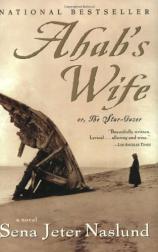Reading Group Guide
Discussion Questions
Ahab's Wife: Or, The Star-Gazer

1. Ahab's Wife takes place in the early nineteenth century. In what ways is Una's story a product of the times in which she lives? In what ways are her experiences timeless?
2. Early on in Una's life, her mother instructs her, "Accept the world, Una. It is what it is" (p. 29). Does she?
3. In many ways, Ahab's Wife is a spiritual journey. What are the forces that guide Una? What is her notion of her place in the universe and how does it evolve over the course of her lifetime?
4. Una writes, "Let me assure you and tell you that I know you, even something of your pain and joy, for you are much like me. The contract of writing and reading requires that we know each other. Did you know that I try on your mask from time to time? I become a reader, too" (p. 148). Several times throughout this book, Una addresses the reader directly. What is the effect of this interchange? How do you participate and become a character in this novel?
5. Discuss Una's relationship to the sea.
6. At the most painful time in her life, when she has lost her child and her mother, Una befriends Susan. Why is this relationship so important to Una? What is it that Susan teaches her? Compare and contrast their friendship to Una's friendship with Margaret Fuller.
7. How do you react to Una's cannibalism? Was she justified in doing what she does to survive? Is Giles more culpable because he himself makes the decision and executes the other shipmates? Or is he the most courageous of all because he takes it on himself to make a terrible decision and save those he loved?
8. Throughout Ahab's Wife, Una makes reference to the works of great writers such as William Shakespeare, John Keats, and Homer. What is the effect of drawing on all these other books? How does it enhance, deepen, and expand Ahab's Wife?
9. How does Una reconcile "the inevitable animal within" (p. 256) with her spiritual aspirations?
10. Why do you think that three out of Una's four loves(Giles, Kit, and Ahab(go mad? Is this merely coincidence?
11. Throughout her life, Una explores the art of sewing. Although Maria Mitchell considers sewing to be an act and a skill that confines rather than liberates women, at one point Una supports herself with a needle and thread. Discuss the numerous ways in which images of mending, binding, and sewing inform the telling of this novel.
12. When Una is looking for icebergs on Ahab's ship, she returns his trust "with silence on the subject of a white whale and all his massive innocence" (p. 280). Has she betrayed Ahab? Why does she see the whale as innocent? After Ahab loses his leg and then his life, do you think she continues to see Moby-Dick as innocent?
13. "Beware the treachery of words, Mrs. Sparrow. They mean one thing to one person and the opposite to another" (p. 297), Ahab tells Una. Why do you think Una finally finds her vocation to be working with words?
14. "Wondering what Margaret Fuller would say to such a distinction between spiritual and moral matters, I asked the judge if he thought there was a difference" (p. 383). Do you think there is a difference?
15. Una's narrative plunges back in time, leaps ahead, and loops over itself again. Different sections are told through other characters' perspectives and through their letters. How does the narrative structure itself enact some of Una's beliefs about the world?
16. The alternate title of this book is The Star-Gazer. Why do you think Ms. Naslund chose to have an alternate title at all? What meanings does it hold?
Ahab's Wife: Or, The Star-Gazer
- Publication Date: October 1, 2000
- Paperback: 688 pages
- Publisher: Harper Perennial
- ISBN-10: 0688177859
- ISBN-13: 9780688177850








